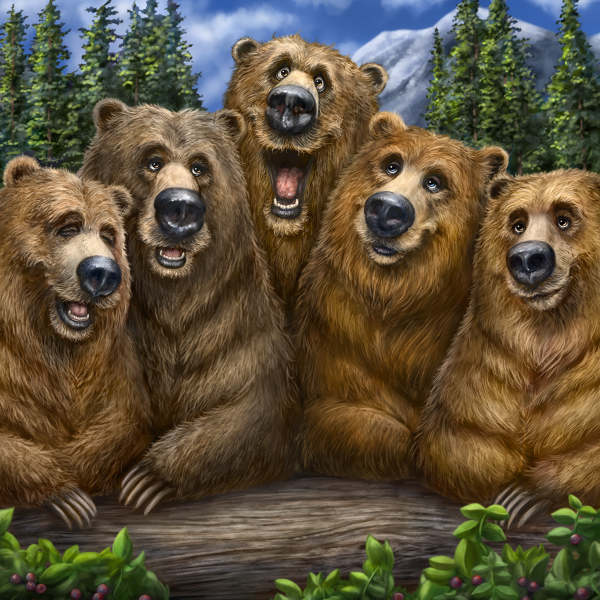
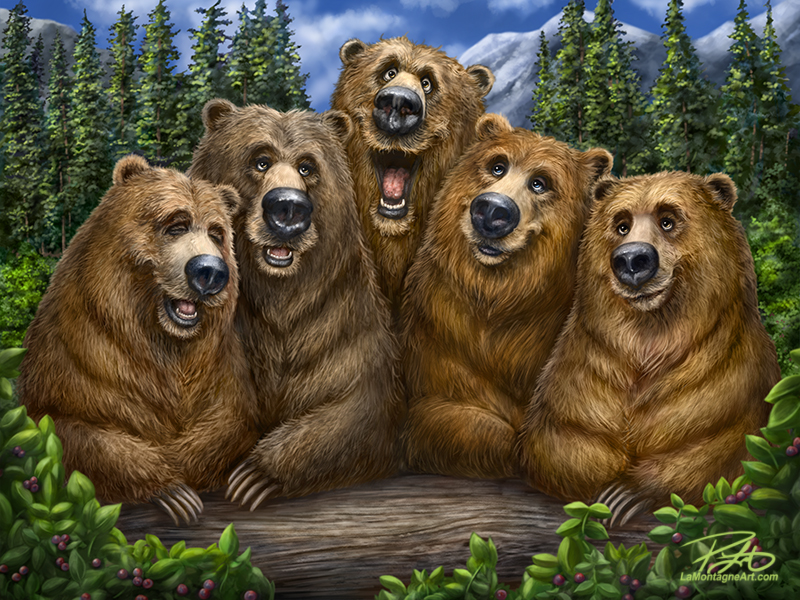 “How long does it take you to paint one of these?”
“How long does it take you to paint one of these?”
It’s one of the most common questions I get.
Do I include all the time and travel? Taking, sorting and editing reference photos? How about sketches and roughs? What about the paintings where I took the reference a few years ago but wasn’t inspired by them until much later?
I’ve never completed a painting in one sitting. It’s usually one or two hours at a time. When I’m not painting, I draw editorial cartoons, do my bookkeeping, admin work, format and order products, email clients, and try to have a life, none of which is on a schedule. Sometimes, I start a painting and don’t return to it for a week. Right now, I have at least five paintings in different stages of completion.
So, technically, I have no idea how long it really takes to complete each painting.
But rather than bore a market booth customer with a complicated, existential answer to a simple question, I usually ballpark it and say, “Somewhere around 15 or 20 hours.”
I don’t know if that’s more or less than what they expected.
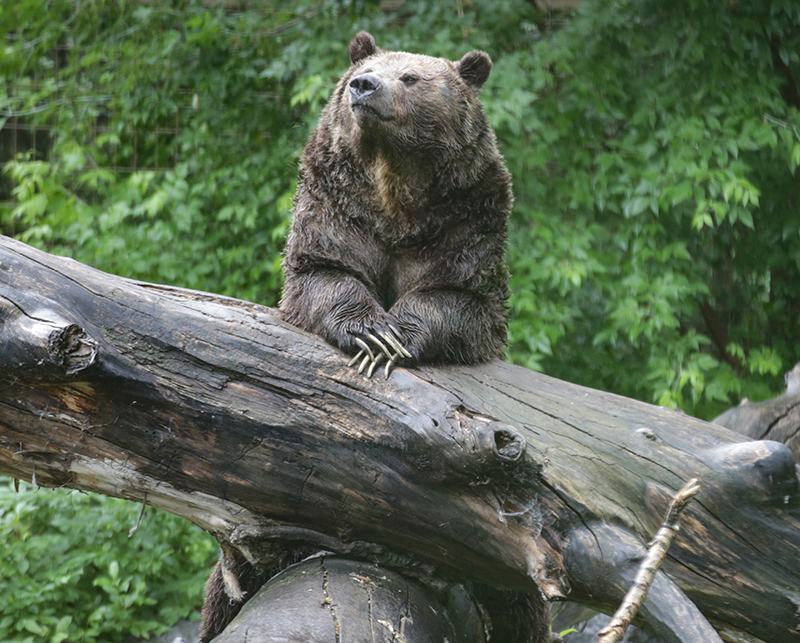 The spark for this painting was reference photos I took at the Calgary Zoo in June of 2023. I enjoyed watching long-time grizzly resident Skoki straddle a log while resting his arms on another log across it. It reminded me of somebody bellying up to a bar to order a drink.
The spark for this painting was reference photos I took at the Calgary Zoo in June of 2023. I enjoyed watching long-time grizzly resident Skoki straddle a log while resting his arms on another log across it. It reminded me of somebody bellying up to a bar to order a drink.
He sat there for a good long while and I took dozens of photos of him turning this way and that. The painting that first came to mind was four or five grizzlies sitting at the log, like buddies at the bar. I even figured I might call it Grizzly Bar.
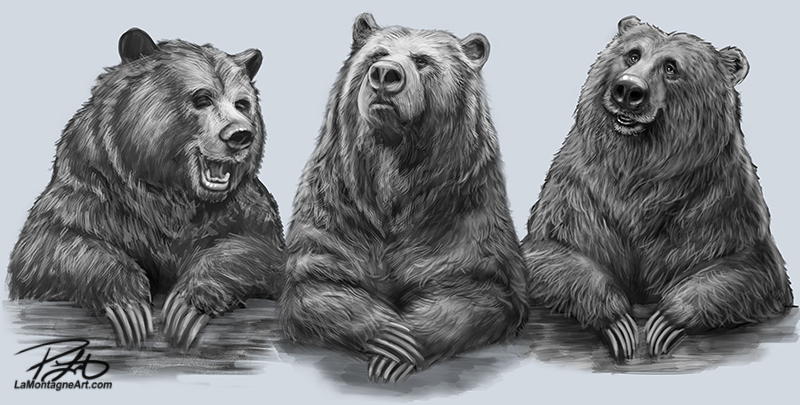 I did some drawings shortly after that and returned to them whenever I had the time. While Skoki was the inspiration, I used several bears in my photo archive as reference for the bodies and faces. If nothing else, I figured they would be good sketches for the book I’ve been talking about for years, but to my eternal shame, never deliver.
I did some drawings shortly after that and returned to them whenever I had the time. While Skoki was the inspiration, I used several bears in my photo archive as reference for the bodies and faces. If nothing else, I figured they would be good sketches for the book I’ve been talking about for years, but to my eternal shame, never deliver.
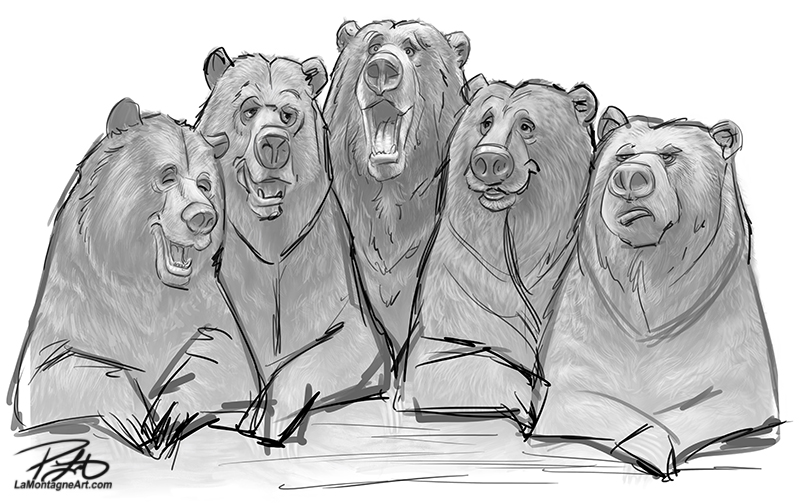 Once I had several sketches, I pieced them together, trying to find a composition I liked. The five grizzly bear buddies soon became five members of a family. It reminded me of a grizzly bear version of a Sears family portrait photo shoot. Refining the shapes so they fit together, and reimagining the expressions meant losing a lot of the sketch detail I had already drawn, but that’s just part of the process.
Once I had several sketches, I pieced them together, trying to find a composition I liked. The five grizzly bear buddies soon became five members of a family. It reminded me of a grizzly bear version of a Sears family portrait photo shoot. Refining the shapes so they fit together, and reimagining the expressions meant losing a lot of the sketch detail I had already drawn, but that’s just part of the process.
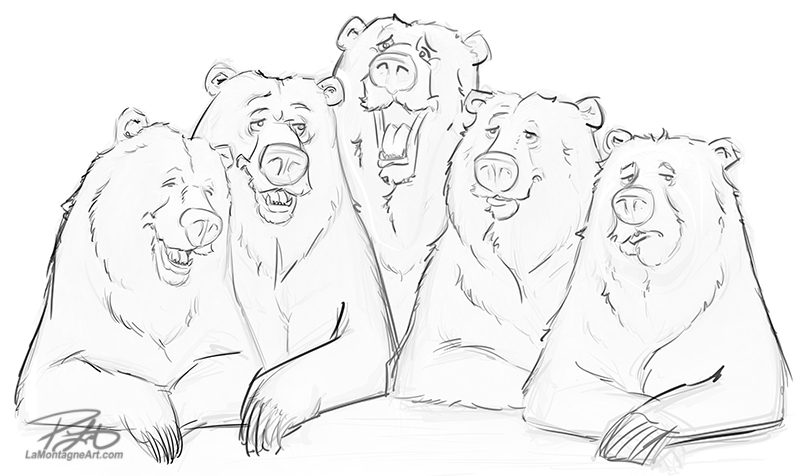 Many paintings begin as one idea but take on their own life while I work. I have no idea how many hours I’ve put into this piece, but it’s more than any painting before.
Many paintings begin as one idea but take on their own life while I work. I have no idea how many hours I’ve put into this piece, but it’s more than any painting before.
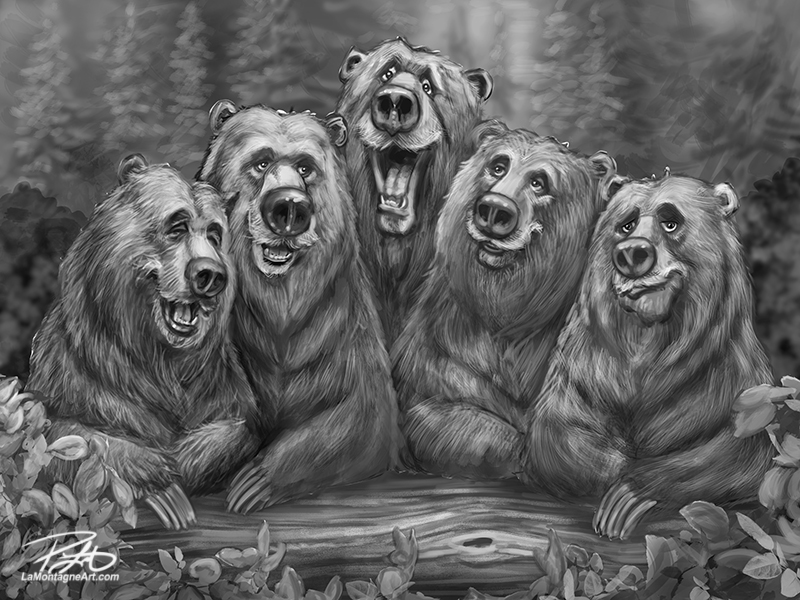 Rather than work in colour from the start, as with other paintings, I started this one in greyscale because I wanted to play with the values and experiment with the scene. Once I had a good starting point, I painted colour in the background and foreground, leaving the grizzlies for last.
Rather than work in colour from the start, as with other paintings, I started this one in greyscale because I wanted to play with the values and experiment with the scene. Once I had a good starting point, I painted colour in the background and foreground, leaving the grizzlies for last.
I’ll confess I don’t much like painting landscapes or scenery, so I wanted to get that out of the way to get to the part I love most — the bears, of course.
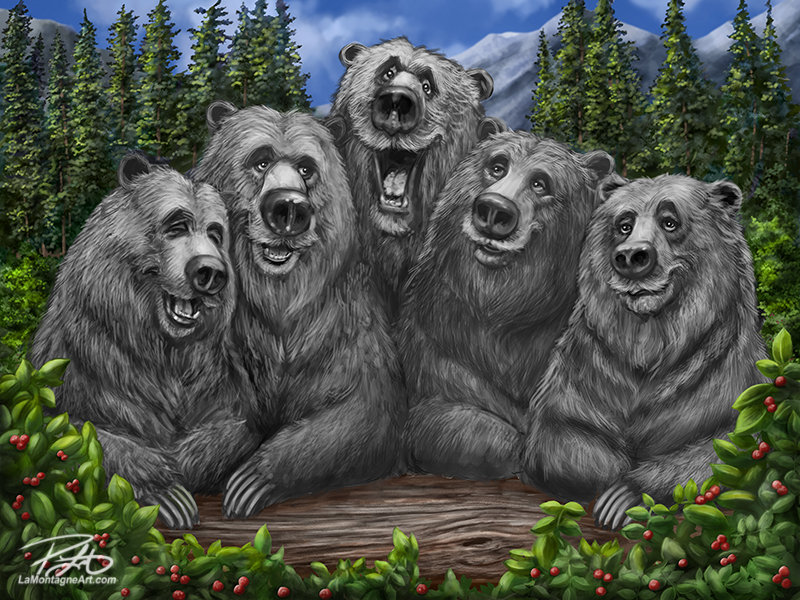 Initially, the berries in the foreground were bright red. But when I showed this work-in-progress image to my buddy, Derek, at Electric Grizzly Tattoo, he suggested they might be a distraction from the bears. It was a helpful critique. So, I toned down the berries and made them a deeper burgundy and blue.
Initially, the berries in the foreground were bright red. But when I showed this work-in-progress image to my buddy, Derek, at Electric Grizzly Tattoo, he suggested they might be a distraction from the bears. It was a helpful critique. So, I toned down the berries and made them a deeper burgundy and blue.
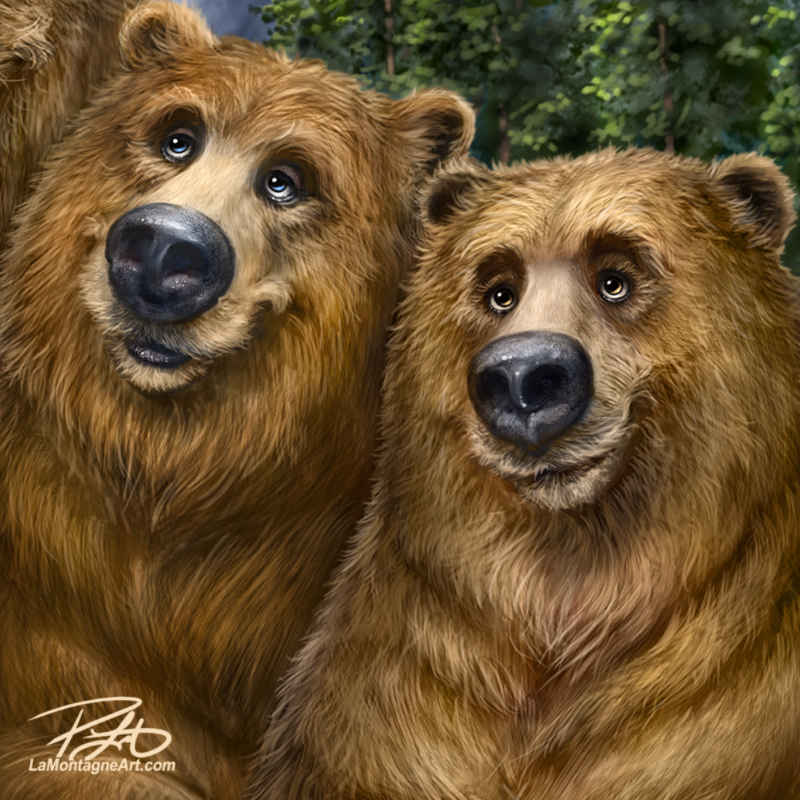 As brown bears come in many shades, from dark brown to red to blonde, I had initially planned to have a more noticeable colour difference between the five. But it looked weird, and I didn’t like it, so I erred on the side of more subtle variations in fur colour.
As brown bears come in many shades, from dark brown to red to blonde, I had initially planned to have a more noticeable colour difference between the five. But it looked weird, and I didn’t like it, so I erred on the side of more subtle variations in fur colour.
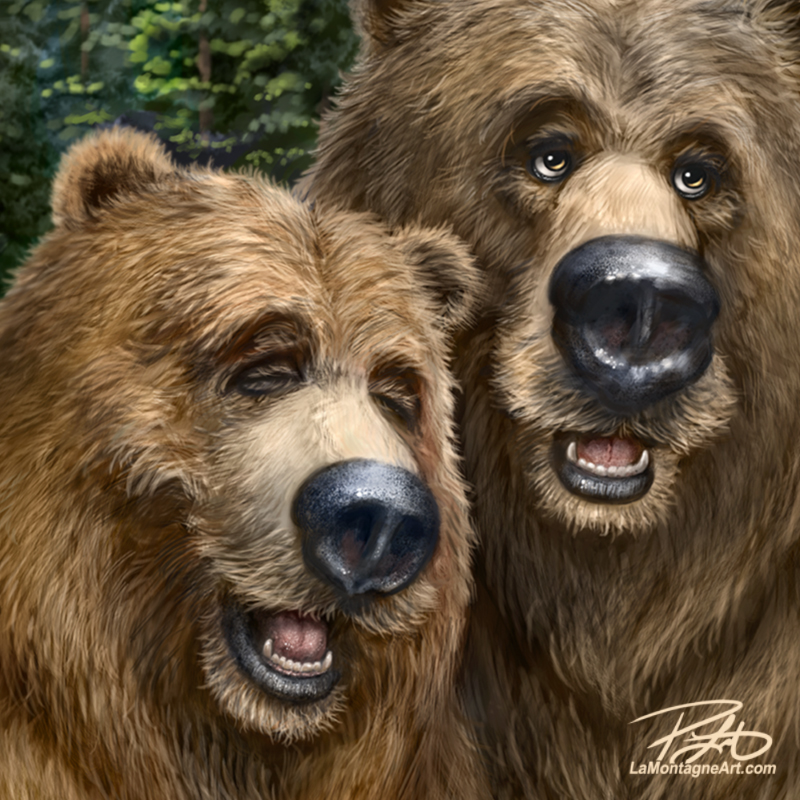 One of the nice things about working digitally is that at the end of each painting session, I can look back at the image when I opened the file and compare it to progress at the end of a session. It’s often a big difference, and that’s satisfying. However, when a painting nears completion, two hours of work may be barely noticeable before and after. That’s usually how I know it’s time to call it done.
One of the nice things about working digitally is that at the end of each painting session, I can look back at the image when I opened the file and compare it to progress at the end of a session. It’s often a big difference, and that’s satisfying. However, when a painting nears completion, two hours of work may be barely noticeable before and after. That’s usually how I know it’s time to call it done.
For you digital painters, this was a very big file with a lot of detail. The finished dimensions are 30″X40″ at 300ppi. Near the end of this piece, with seven layers, the working file size was over 1.5GB. Thankfully my computer can handle it, but I still closed and reopened the program every half hour or so to prevent any lag. With a file this big, a crash can happen and losing an hour of work is a real risk.
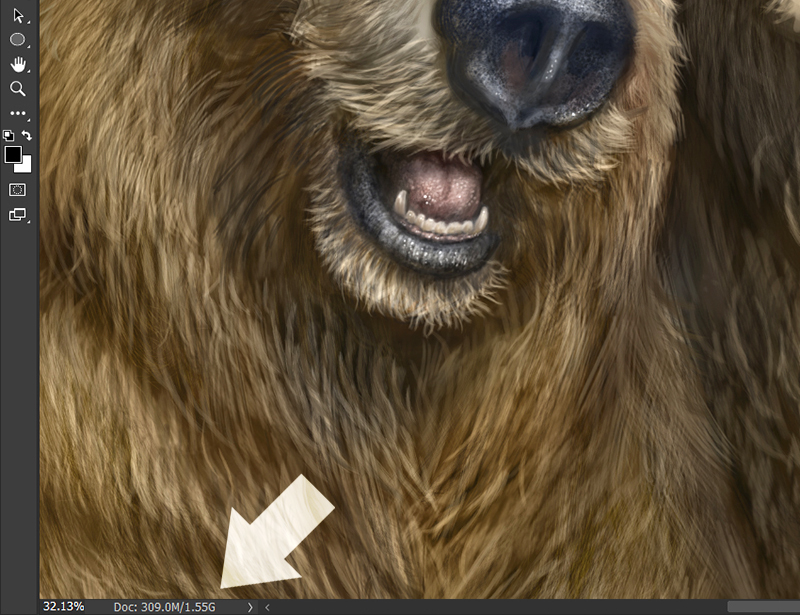 Deciding whether I like a piece or not takes time, but I’m pretty happy with how this turned out. I liked my Meerkat piece when I finished it, but it took four weeks of it hanging on the grid wall beside me at The Banff Christmas Market before I realized it’s one of my personal favourites.
Deciding whether I like a piece or not takes time, but I’m pretty happy with how this turned out. I liked my Meerkat piece when I finished it, but it took four weeks of it hanging on the grid wall beside me at The Banff Christmas Market before I realized it’s one of my personal favourites.
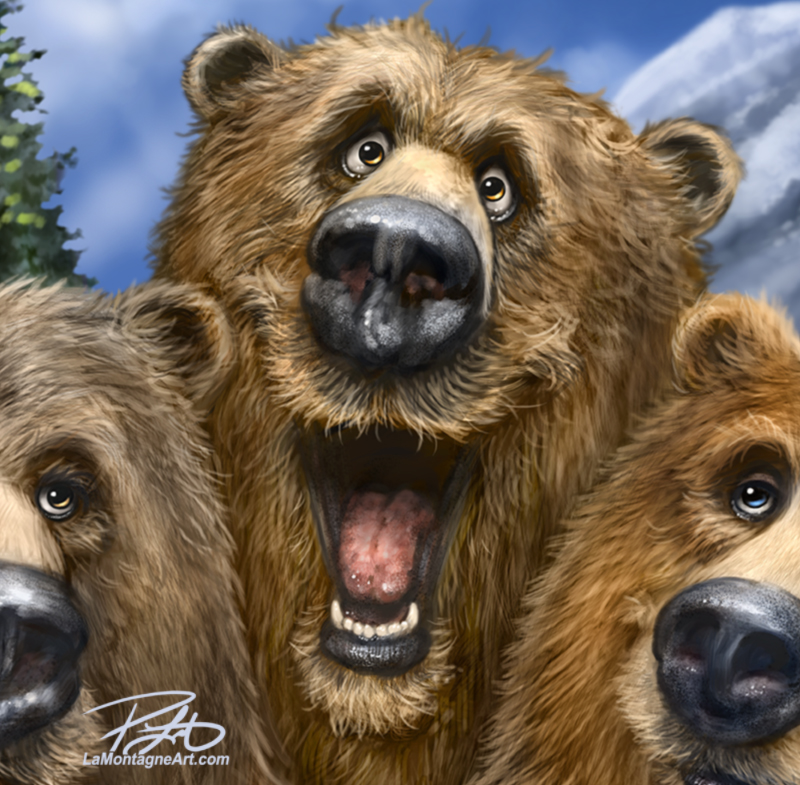 Because of the current uncertain economy, I’m not yet committing to doing puzzles again right away. But when I do, I think this grizzly family is worthy of consideration.
Because of the current uncertain economy, I’m not yet committing to doing puzzles again right away. But when I do, I think this grizzly family is worthy of consideration.
What do you think? Let me know in the comments.

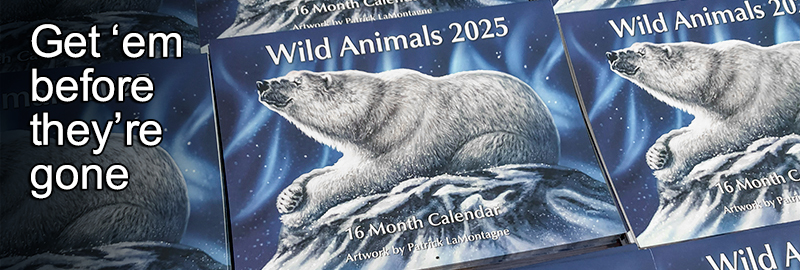
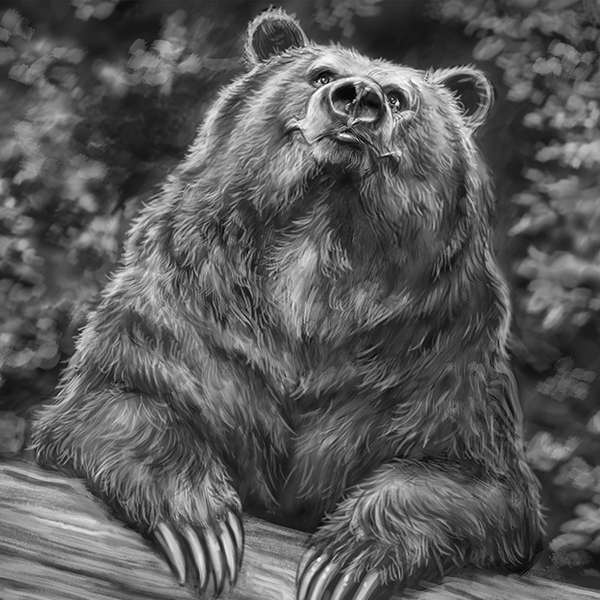
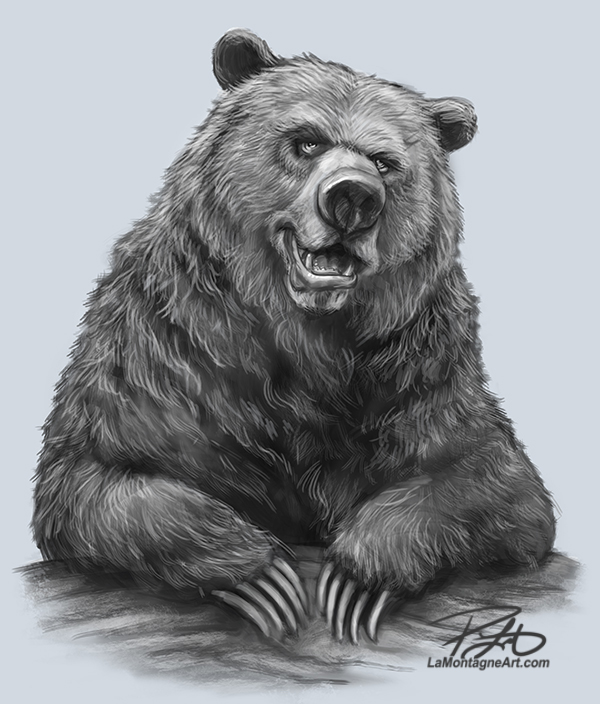 I rarely visit the
I rarely visit the 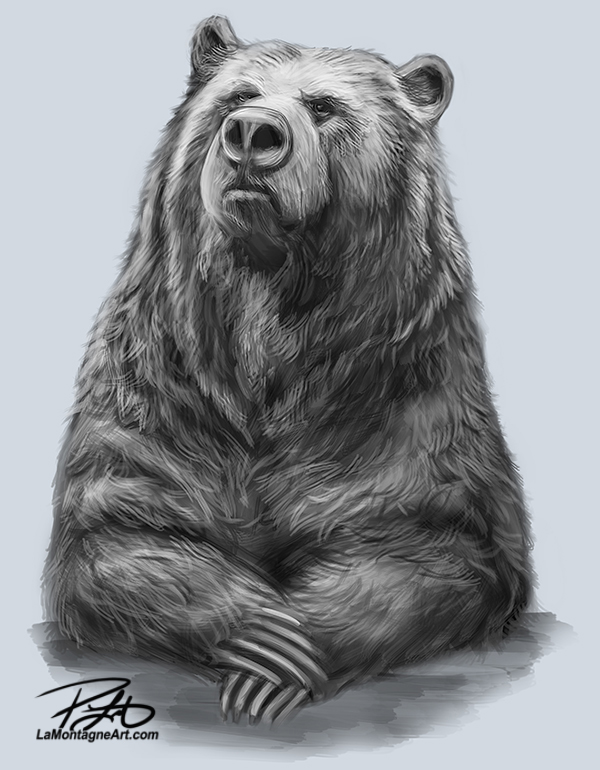 Parks Canada officials would have euthanized Bear #16 in 1996, but the Calgary Zoo had an opening, and he has lived there ever since. In the wild, a male grizzly doesn’t live far past his 20s. Skoki is now 37 years old. He is an old bear and looks it, but despite obvious age-related deficiencies, he’s healthy.
Parks Canada officials would have euthanized Bear #16 in 1996, but the Calgary Zoo had an opening, and he has lived there ever since. In the wild, a male grizzly doesn’t live far past his 20s. Skoki is now 37 years old. He is an old bear and looks it, but despite obvious age-related deficiencies, he’s healthy.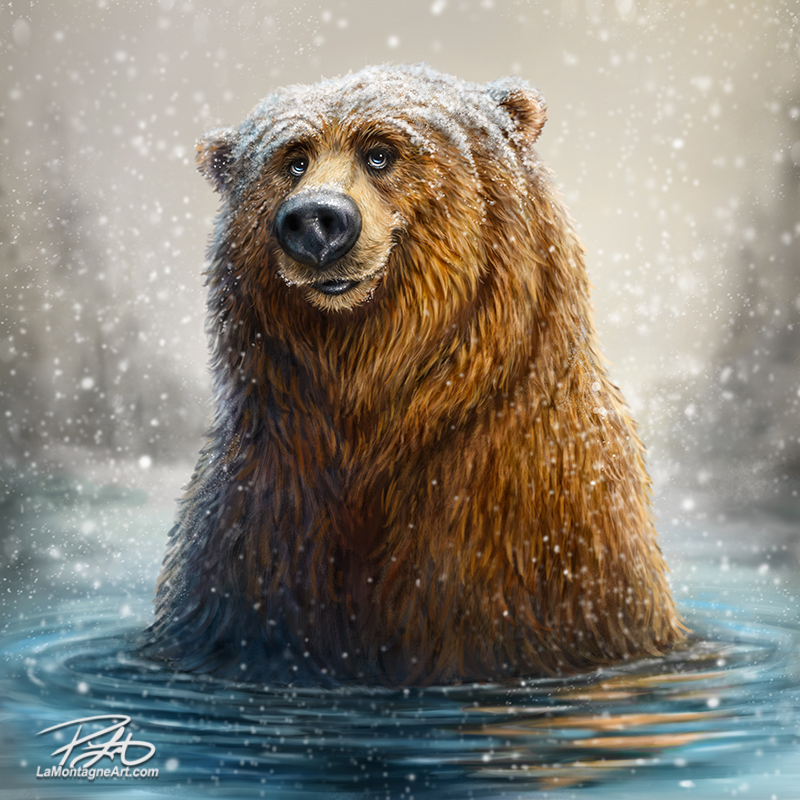
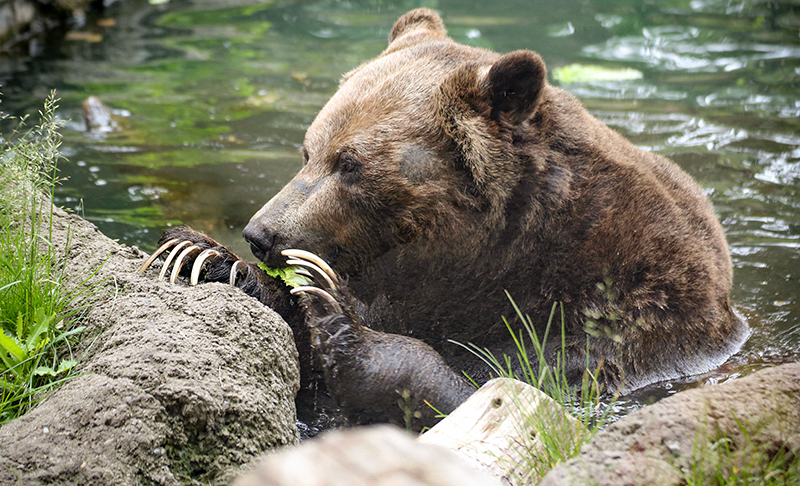 One day in June last year, after dropping off prints, I found Skoki active again. I followed him around his large enclosure until he did something I’d never seen before. He walked the length of a log until he came to a larger log that crossed it. He straddled the one on which he’d been walking and put his paws up on the crossed log. He looked like he’d just bellied up to the bar and was waiting for service.
One day in June last year, after dropping off prints, I found Skoki active again. I followed him around his large enclosure until he did something I’d never seen before. He walked the length of a log until he came to a larger log that crossed it. He straddled the one on which he’d been walking and put his paws up on the crossed log. He looked like he’d just bellied up to the bar and was waiting for service.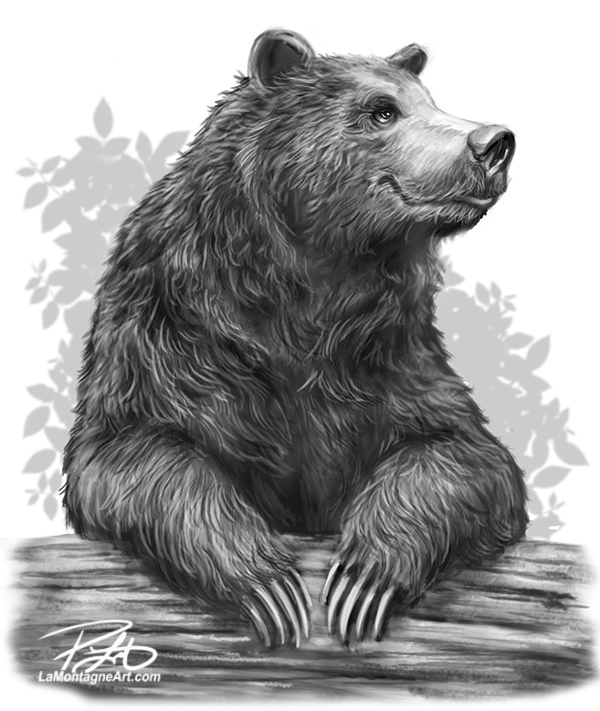 This painting has been rattling around in my noggin for quite a while, and I’ve drawn several sketches, including the ones in this post. All the reference I’m using for this work in progress is Skoki, but I’ll make the five bears different heights, weights and colour variations so they don’t all look like the same bear. Other photo references will help me do that, and I’m planning more sketches like these to explore my options.
This painting has been rattling around in my noggin for quite a while, and I’ve drawn several sketches, including the ones in this post. All the reference I’m using for this work in progress is Skoki, but I’ll make the five bears different heights, weights and colour variations so they don’t all look like the same bear. Other photo references will help me do that, and I’m planning more sketches like these to explore my options.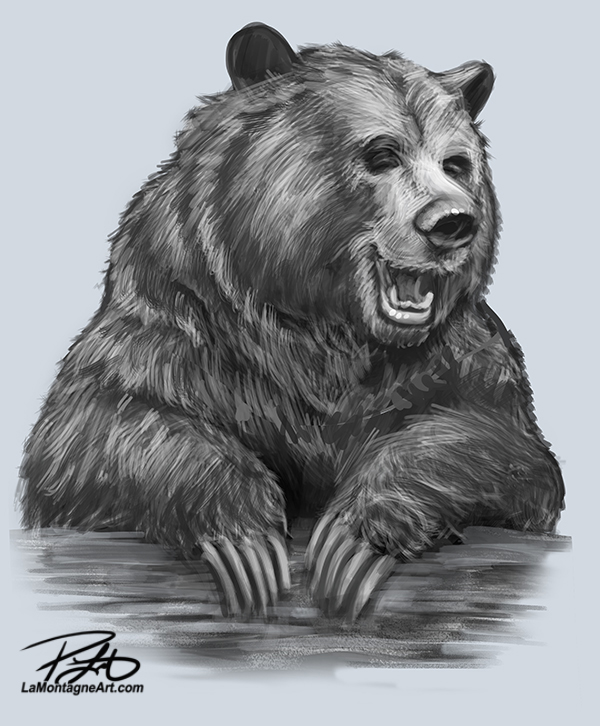 I started one of these Skoki sketches a little while ago and figured I’d try a full pose of how he sat that day. Before I knew it, I had drawn more detail and realized the image below was becoming its own painting.
I started one of these Skoki sketches a little while ago and figured I’d try a full pose of how he sat that day. Before I knew it, I had drawn more detail and realized the image below was becoming its own painting.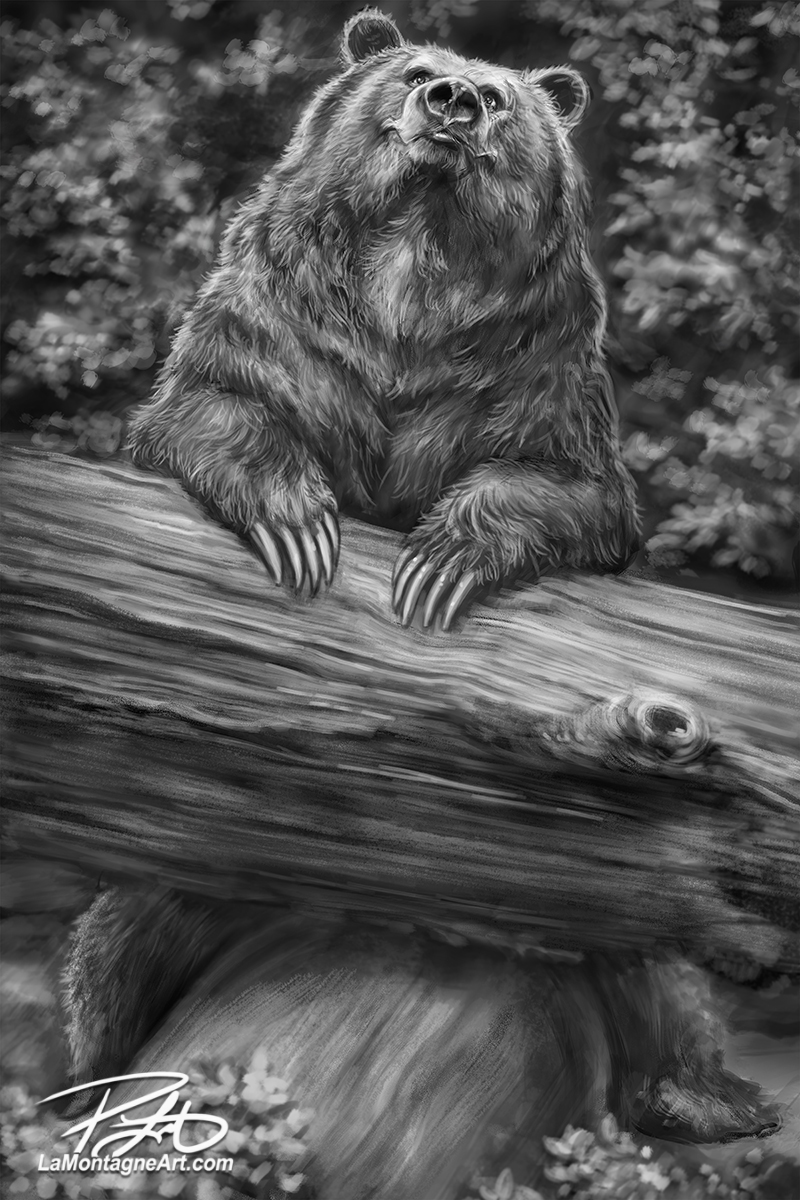 Because I don’t paint a lot of backgrounds in my work, I’ll often begin some paintings in grayscale so I can get the light, shadows and contrast right. Later, I can add colour using various techniques I’ve discovered in over twenty years of digital painting.
Because I don’t paint a lot of backgrounds in my work, I’ll often begin some paintings in grayscale so I can get the light, shadows and contrast right. Later, I can add colour using various techniques I’ve discovered in over twenty years of digital painting.
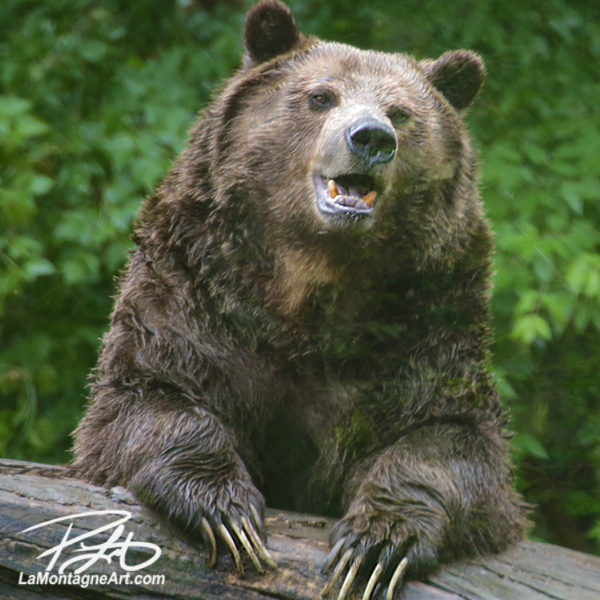
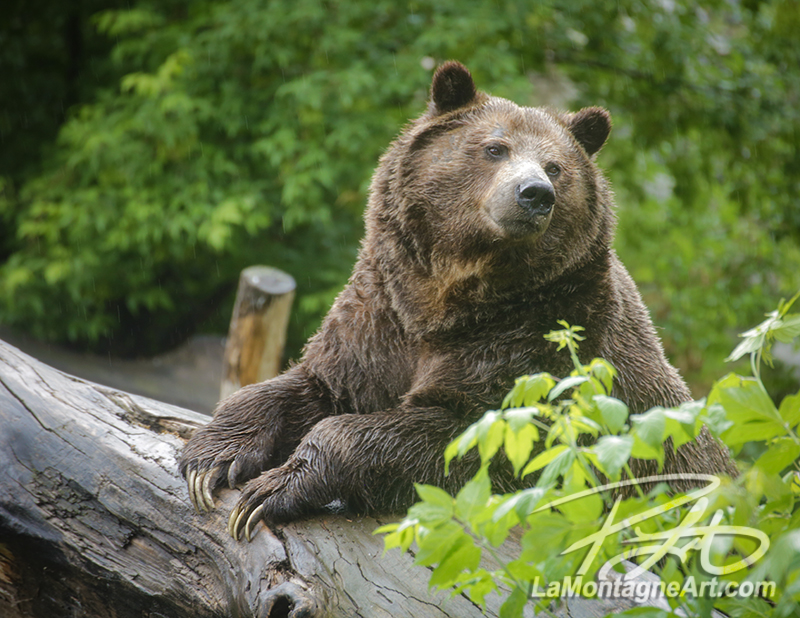 On Wednesday, I delivered a large print order to the Calgary Zoo. A zookeeper friend had ordered a couple of canvases, so I was also happy to deliver those to her.
On Wednesday, I delivered a large print order to the Calgary Zoo. A zookeeper friend had ordered a couple of canvases, so I was also happy to deliver those to her.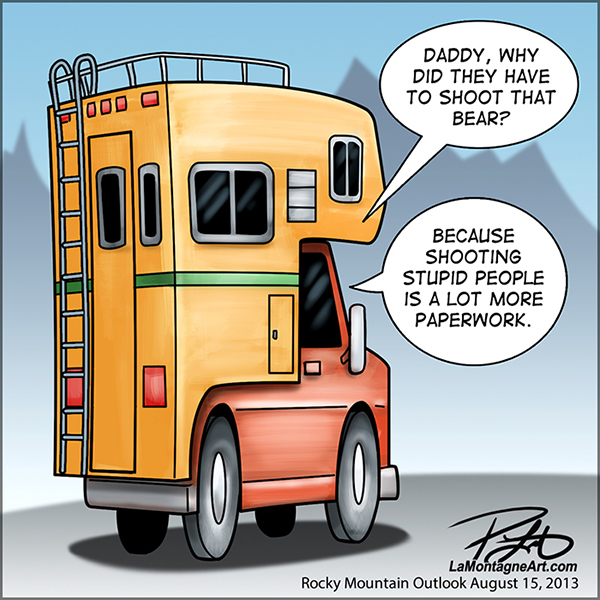 People leave food out while camping which attracts wildlife. When a bear associates people with food, it’s game over for the bear. I’ve lived in this valley for almost thirty years, and I don’t want to count how many times I’ve read about bears who’ve been euthanized because of selfish and careless people.
People leave food out while camping which attracts wildlife. When a bear associates people with food, it’s game over for the bear. I’ve lived in this valley for almost thirty years, and I don’t want to count how many times I’ve read about bears who’ve been euthanized because of selfish and careless people.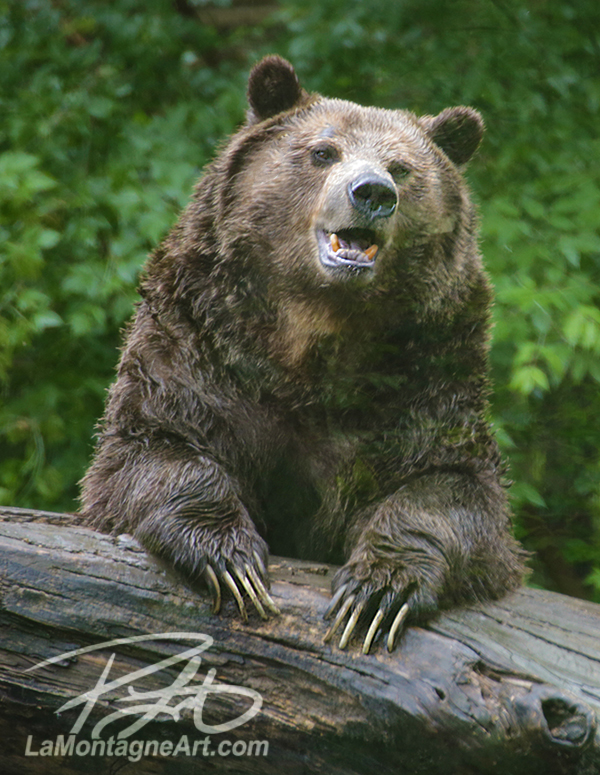 The more people repeat Skoki’s story, the more they educate young people to want to protect them in the wild and prevent them from being put in a zoo or destroyed.
The more people repeat Skoki’s story, the more they educate young people to want to protect them in the wild and prevent them from being put in a zoo or destroyed.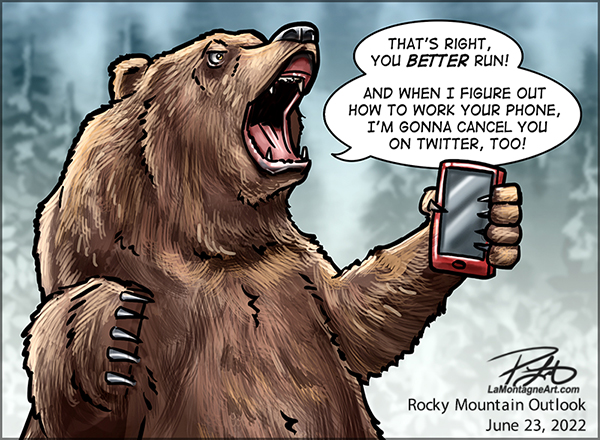 I must have taken about 700+ shots of Skoki on Wednesday. He gave me so many beautiful poses. At one point, he walked across a log, sat up and straddled it, then hung out there. The wind came up, and he was sniffing the air, clearly enjoying the rain, and I ended up with many great references. Look at those little feet.
I must have taken about 700+ shots of Skoki on Wednesday. He gave me so many beautiful poses. At one point, he walked across a log, sat up and straddled it, then hung out there. The wind came up, and he was sniffing the air, clearly enjoying the rain, and I ended up with many great references. Look at those little feet.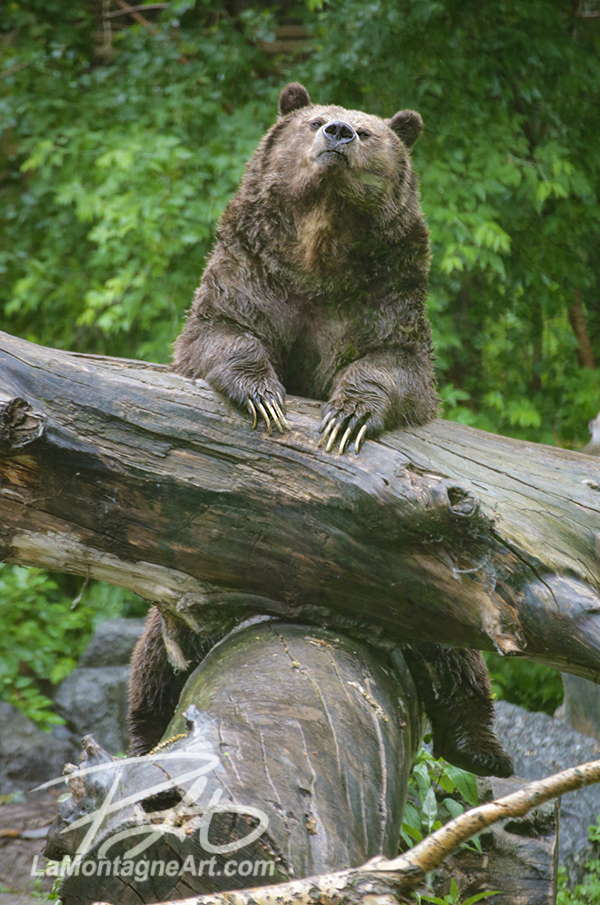 He gave me a great idea for a painting. I imagine several bears lined up at a log, like a bunch of friends hanging out at a bar. With his multiple poses and expressions in the same spot, I can paint five or six different bears using him as the reference. I’ll paint the faces and bodies differently for variety, making one thinner, another heavier, taller, and shorter; there are plenty of options. By varying the colours, the finished bears will look like their own characters, but the primary reference will still be one bear.
He gave me a great idea for a painting. I imagine several bears lined up at a log, like a bunch of friends hanging out at a bar. With his multiple poses and expressions in the same spot, I can paint five or six different bears using him as the reference. I’ll paint the faces and bodies differently for variety, making one thinner, another heavier, taller, and shorter; there are plenty of options. By varying the colours, the finished bears will look like their own characters, but the primary reference will still be one bear.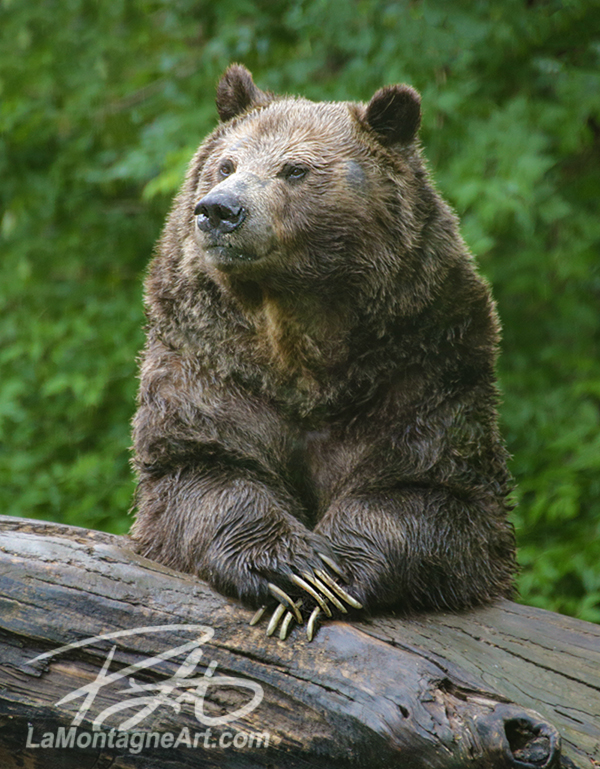 Resuming my walk back to my car about an hour and a half later, it struck me funny that I began the day hoping to get photos of animals I hadn’t yet painted or only painted once but left the zoo with a camera card full of grizzly bear photos. I have more pictures of bears than any other animal.
Resuming my walk back to my car about an hour and a half later, it struck me funny that I began the day hoping to get photos of animals I hadn’t yet painted or only painted once but left the zoo with a camera card full of grizzly bear photos. I have more pictures of bears than any other animal.